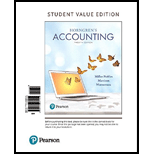
Horngren's Accounting, Student Value Edition (12th Edition)
12th Edition
ISBN: 9780134487151
Author: Tracie L. Miller-Nobles, Brenda L. Mattison, Ella Mae Matsumura
Publisher: PEARSON
expand_more
expand_more
format_list_bulleted
Concept explainers
Textbook Question
Chapter 21, Problem 11AQC
Donovan Company incurred the following costs while producing 500 units: direct materials, $10 per unit; direct labor, $25 per unit; variable manufacturing
11 A. What is the unit product cost using variable costing?
Learning Objective 6 Appendix 21A
a. $50 per unit
b. $55 per unit
c. $70 per unit
d. $90 per unit
Expert Solution & Answer
Want to see the full answer?
Check out a sample textbook solution
Students have asked these similar questions
Financial Accounting
Quick answer of this accounting questions
4 PTS
Chapter 21 Solutions
Horngren's Accounting, Student Value Edition (12th Edition)
Ch. 21 - For Frank’s Funky Sounds, straight-line...Ch. 21 - Prob. 2QCCh. 21 - Prob. 3QCCh. 21 - Prob. 4QCCh. 21 - Prob. 5QCCh. 21 - On a CVP graph, the total cost line intersects the...Ch. 21 - If a company increases its sales price per unit...Ch. 21 - Prob. 8QCCh. 21 - Prob. 9QCCh. 21 - Prob. 10QC
Ch. 21 - Donovan Company incurred the following costs while...Ch. 21 - Prob. 12AQCCh. 21 - Prob. 1RQCh. 21 - Prob. 2RQCh. 21 - What is a mixed cost? Give an example.Ch. 21 - What is the purpose of using the high-low method?Ch. 21 - Describe the three steps of the high-low method.Ch. 21 - What is the relevant range?Ch. 21 - A chain of convenience stores has one manager per...Ch. 21 - A chain of convenience stores has one manager per...Ch. 21 - Prob. 9RQCh. 21 - Prob. 10RQCh. 21 - Prob. 11RQCh. 21 - What is cost-volume-profit analysis?Ch. 21 - Prob. 13RQCh. 21 - Prob. 14RQCh. 21 - Prob. 15RQCh. 21 - Of the three approaches to calculate sales...Ch. 21 - Prob. 17RQCh. 21 - Prob. 18RQCh. 21 - On the CVP graph, where is the breakeven point...Ch. 21 - What is sensitivity analysis? How do managers use...Ch. 21 - Prob. 21RQCh. 21 - What is cost stickiness? Why do managers need to...Ch. 21 - Prob. 23RQCh. 21 - What is a company's cost structure? How can cost...Ch. 21 - What is operating leverage? What does it mean if a...Ch. 21 - Prob. 26RQCh. 21 - What is absorption costing?Ch. 21 - What is variable costing?Ch. 21 - How are absorption costing and variable costing...Ch. 21 - When units produced equal units sold, how does...Ch. 21 - Prob. 31ARQCh. 21 - Prob. 32ARQCh. 21 - Identifying variable, fixed, and mixed costs...Ch. 21 - Prob. S21.2SECh. 21 - Using the high-low method Learning Objective 1...Ch. 21 - Prob. S21.4SECh. 21 - Prob. S21.5SECh. 21 - Prob. S21.6SECh. 21 - Prob. S21.7SECh. 21 - Computing contribution margin, units and required...Ch. 21 - Prob. S21.9SECh. 21 - Prob. S21.10SECh. 21 - Prob. S21.11SECh. 21 - Use the following information to complete Short...Ch. 21 - Use the following information to complete Short...Ch. 21 - Prob. S21.14SECh. 21 - Prob. S21.15SECh. 21 - Prob. S21.16SECh. 21 - Prob. S21.17SECh. 21 - S21A-18 Classifying costs
Learning Objective 6...Ch. 21 - Use the following information for Short Exercises...Ch. 21 - Prob. S21A.20SECh. 21 - Prob. S21A.21SECh. 21 - Prob. S21A.22SECh. 21 - Prob. S21A.23SECh. 21 - Prob. S21A.24SECh. 21 - Prob. S21A.25SECh. 21 - Prob. S21A.26SECh. 21 - Prob. E21.27ECh. 21 - Prob. E21.28ECh. 21 - Prob. E21.29ECh. 21 - Prob. E21.30ECh. 21 - Prob. E21.31ECh. 21 - Prob. E21.32ECh. 21 - Prob. E21.33ECh. 21 - Prob. E21.34ECh. 21 - Prob. E21.35ECh. 21 - Prob. E21.36ECh. 21 - Prob. E21.37ECh. 21 - Prob. E21.38ECh. 21 - Prob. E21.39ECh. 21 - Prob. E21.40ECh. 21 - Prob. E21.41ECh. 21 - Prob. E21.42ECh. 21 - Prob. E21.43ECh. 21 - Prob. E21.44ECh. 21 - Prob. E21.45ECh. 21 - Prob. E21A.46ECh. 21 - Prob. E21A.47ECh. 21 - Prob. E21A.48ECh. 21 - Prob. E21A.49ECh. 21 - Prob. E21A.50ECh. 21 - Prob. E21A.51ECh. 21 - Prob. E21A.52ECh. 21 - Prob. E21A.53ECh. 21 - Prob. P21.54APGACh. 21 - Prob. P21.55APGACh. 21 - Analyzing CVP relationships Learning Objectives...Ch. 21 - Prob. P21.57APGACh. 21 - Prob. P21.58APGACh. 21 - Prob. P21A.59APGACh. 21 - Prob. P21A.60APGACh. 21 - Prob. P21.61BPGBCh. 21 - Prob. P21.62BPGBCh. 21 - Prob. P21.63BPGBCh. 21 - Prob. P21.64BPGBCh. 21 - Prob. P21.65BPGBCh. 21 - Prob. P21A.66BPGBCh. 21 - Prob. P21A.67BPGBCh. 21 - Using Excel for cost-volume-profit(CVP) analysis...Ch. 21 - Prob. P21.69CPCh. 21 - Comprehensive Problem for Chapters 18- 21 The...Ch. 21 - Comprehensive Problem for Chapters 18- 21 The...Ch. 21 - Comprehensive Problem for Chapters 18- 21 The...Ch. 21 - Comprehensive Problem for Chapters 18- 21 The...Ch. 21 - Comprehensive Problem for Chapters 18- 21 The...Ch. 21 - Prob. 6CPCh. 21 - Prob. 21.1TIATCCh. 21 - Prob. 21.1DCCh. 21 - Prob. 21.1EI
Knowledge Booster
Learn more about
Need a deep-dive on the concept behind this application? Look no further. Learn more about this topic, accounting and related others by exploring similar questions and additional content below.Similar questions
- Need Ans financial accounting questionarrow_forwardLast year, Baron Enterprises had $350 million of sales, and it had $270 million of fixed assets that were used at 65% of capacity last year. In millions, by how much could Baron's sales increase before it is required to increase its fixed assets? a. $170.09 b. $179.04 c. $188.46 d. $197.88 e. $207.78 MCQarrow_forwardI want A B answer general accounting questionarrow_forward
arrow_back_ios
SEE MORE QUESTIONS
arrow_forward_ios
Recommended textbooks for you
 Essentials of Business Analytics (MindTap Course ...StatisticsISBN:9781305627734Author:Jeffrey D. Camm, James J. Cochran, Michael J. Fry, Jeffrey W. Ohlmann, David R. AndersonPublisher:Cengage Learning
Essentials of Business Analytics (MindTap Course ...StatisticsISBN:9781305627734Author:Jeffrey D. Camm, James J. Cochran, Michael J. Fry, Jeffrey W. Ohlmann, David R. AndersonPublisher:Cengage Learning

Essentials of Business Analytics (MindTap Course ...
Statistics
ISBN:9781305627734
Author:Jeffrey D. Camm, James J. Cochran, Michael J. Fry, Jeffrey W. Ohlmann, David R. Anderson
Publisher:Cengage Learning
What is variance analysis?; Author: Corporate finance institute;https://www.youtube.com/watch?v=SMTa1lZu7Qw;License: Standard YouTube License, CC-BY